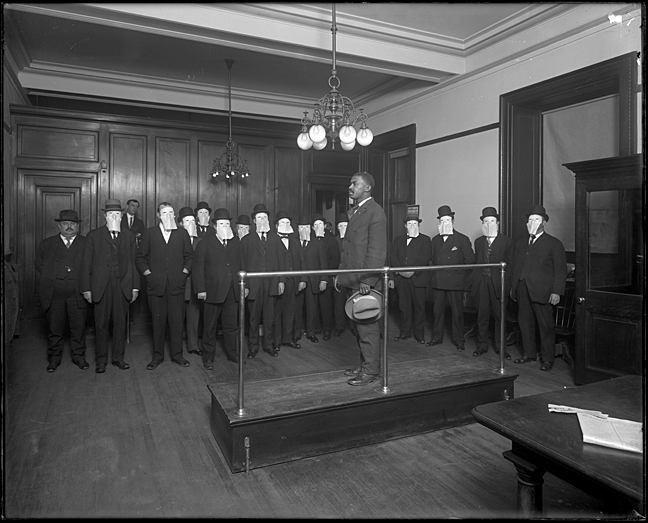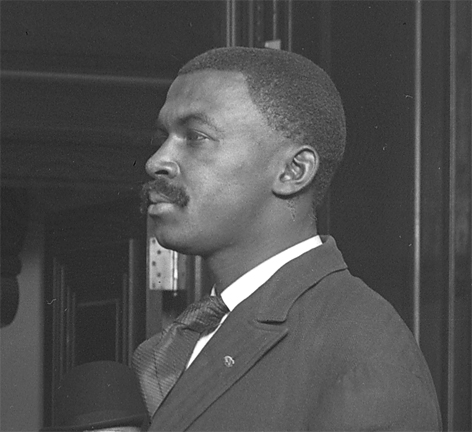Masked Mystery

What do you think is going on in this photograph? “Detective room, Police Department,” Hughes Company Photograph Collection, unknown photographer (possibly James W. Scott), ca.1910, MdHS, PP8-585 / Z9.584.PP8
Last month we solved a longstanding photograph mystery that we never expected to solve, that is until we rolled up our sleeves and actually tried. Modern digitization technology, more precisely the ability to zoom deep into a photo or negative to see details previously unavailable to the naked eye, coupled with searchable newspaper databases make solving these puzzles much easier today. But this time out, we have a longstanding photo mystery that we can’t solve on our own. Having exhausted every resource we could muster, from searching historic newspaper databases to asking historians and journalists (we even tried asking federal archival investigators who visited us during the Landau theft case), we still can’t say with any degree of certainty what’s going on in the disturbing photo above. Yet its imagery evokes such strong feelings, conjuring up images of Jim Crow, the Klan, and lynching, we can’t give up trying to understand it—so we turn to crowd sourcing.

Why are some of these men not wearing masks? Is that a telephone between the shoulders of the two men in the middle? Would there have been a telephone in a court room?
Immediately several questions come to mind: What is happening to this man? Why are the men wearing masks? Are they police officers? Are they a jury? Stare a little longer and other questions arise: What year would this be? Why are two of the men seen above not wearing masks? Why does the African-American man seem so calm?

Not a drop of sweat. Despite what’s going on behind him, this man does not appear worried. How do you interpret his expression?
Here’s what we do know
This photo is labeled “Detective room, Police Department.” However, in the archival world, you quickly learn not to take random descriptions as gospel. It’s part of the Hughes Collection*, one of our largest collections of photographs. James F. Hughes, whose first appearance as a commercial photographer in the City Directory was in 1877, founded the company. He owned the company until his widow sold it to an employee, James W. Scott, in 1903. The Hughes Company primarily did work for Baltimore area businesses, corporations, governmental agencies, and occasionally private individuals.
MdHS’s records indicate that this photo was taken sometime around 1910. Several pieces of evidence corroborate this date. From the lighting fixtures to the suits and hats the men are wearing, this appears to be the early twentieth century, pre-WWI. Additionally, the original medium for the image is an 8 x 10 inch glass plate negative. Glass negatives preceded film negatives. They first appeared in the mid-nineteenth century, but went the way of the dinosaur in the early twentieth century as less fragile celluloid film was introduced. The one item that could answer the “when” question is just a bit too out of focus to help: a newspaper left on a table and opened to an advertisement page:

The date is not visible on this newspaper in the foreground, but we can see that Joel Gutman & Co., which operated from 1852 to 1929, offered mens shoes from $2.79 – $4. These seem to be pre-1920s prices.
Given the approximate date of the photograph, we can safely assume that James Scott, or someone who worked for him after he took over the Hughes Company, took the picture. We know that the company commonly did work for the City of Baltimore. What we don’t know is why a Hughes photographer was at this location on this particular day. There’s also the matter that this room looks far more like a courtroom than a police detective room. Was the photographer there to take promotional pictures for the police department or court system? The shot seems somewhat staged, as if the men were assembled quickly for the shot. Note that three of them are not wearing masks, two on the left and one on the right in a doorway. Anonymity was not crucial for all of the men in the picture. There are fifteen men wearing the very distinctive masks. Could this be a jury with three alternates? Are they witnesses? A staged demonstration might also explain the calm look of the man on the riser. It’s also worth noting that he’s a fairly handsome man and zooming in closeup reveals no sweat on his brow. Additionally he appears to be wearing a wedding ring. What does any of this mean?
One final clue to point out: If this is a detective room or a court room, how do we explain the object behind the head of the man to the right of the man on the riser? What little we can read of it says, WM. J. C. DULANY CO. PUBLISHERS. Is it a calendar or broadside? The photo vexes us at every turn.

Another clue? This is an interesting place to hang a calendar or broadside in a police department or court room. And aren’t these masks peculiar?
Educated guesses
One prominent local historian** suggested that this image represents an initiation ritual for the first black detective of the Baltimore City police force. This seemed a reasonable guess, except that the date range of the collection is 1910-1926. Considering that glass negatives were not used much after the nineteen-teens and that we had never heard of an African-American detective in segregated Baltimore this early, we were left wondering.
The theory was quickly taken down by a veteran journalist who visits the library frequently. “There were no black officers on the force until 1937. Violet Hill Whyte was the first one,” said our source. “African-Americans weren’t even put into uniform until 1943,” he added. The first African-American men hired by the Baltimore Police arrived in 1938. They were Walter T. Eubanks Jr., Harry S. Scott, Milton Gardner, and J. Hiram Butler Jr. These men were not allowed to wear police uniforms for another five years. Even if this were a photo from as late as 1926, which is highly unlikely, it predates the arrival of African-Americans on the force by twelve years.
Left with more questions than answers, we turn to you, our readers. What do you think?
Please share this, leave comments, or send us an e-mail. (Joe Tropea)

